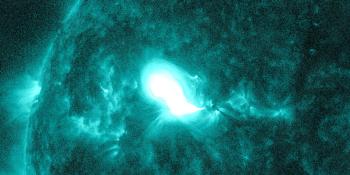Visualizzazione archivio di lunedì, 30 gennaio AM
Rapporto attività solare
Ogni brillamento solare menzionato nel rapporto ha un fattore di scala, applicato dal Centro di Predizione Meteorologica Spaziale (SWPC). A causa del fattore di scala del SWPC, i brillamenti solari sono segnalati come ridotti del 42%, rispetto ai dati di qualità scientifica. Il fattore di scala è stato rimosso dai nostri dati archiviati sui brillamenti solari, per riflettere le unità fisiche reali.
Rapporto dell'Attività Geofisica Solare 2012 Jan 30 2200 UTCPreparati dal SWPC della NOAA© ed elaborati da SpaceWeatherLive.com
Rapporto Congiunto USAF/NOAA dell'Attività Solare e Geofisica
SDF Numero 030 Emesso alle 2200Z il Jan 30 2012IA. Analisi delle Regioni Solari Attive e Attività dalle 2100Z-29 alle 2100Z-30 Solar activity was low. Region 1410 (N24E16) produced a
single C-class x-ray event during the period.
IB. Previsione dell'Attività Solare
Solar activity is expected to be very
low to low over the next 3 days (31 January - 02 February).
IIA. Sommario dell'Attività Geofisica dalle 2100Z-29 alle 2100Z-30
The geomagnetic field was quiet, until the arrival of a glancing blow
from the limb event CME that occurred in association with the X1/1f
flare on 27 January. The transient passage was observed by the ACE
spacecraft at 30/1554Z with a solar wind speed increase from around
350 km/s to near 450 km/s. A weak sudden impulse measuring 8nT was
observed by the Boulder magnetometer at 30/1635Z. Conditions
afterwards ranged from unsettled to quiet. The greater than 10 MeV
proton that began at 27/1905Z and reached a maximum of 796 pfu at
28/0205Z was still in progress at the time of this event, with flux
levels hovering near 20 pfu. The greater than 2 MeV electron flux at
geosynchronous orbit reached high levels during the period.
IIB. Previsione dell'Attività Geofisica
The geomagnetic field is
expected to be mostly quiet for days 1-3 (31 January - 02 February).
The greater than 10 MeV proton flux levels, as observed by NOAA
GOES-13 in geosynchronous orbit, are expected to decay below the 10
pfu threshold in the next day or two.
III. Probabilità dell'Evento dalle Jan del 31 alle Feb del 02
| Classe M | 01% | 01% | 01% |
| Classe X | 01% | 01% | 01% |
| Protone | 99% | 50% | 01% |
| PCAF | yellow | ||
IV. Flusso di 10.7 cm di Penticton
Osservato 30 Jan 114 Previsto 31 Jan-02 Feb 115/115/115 Media di 90 Giorni 30 Jan 143
V. Indici Geomagnetici A
Osservato Afr/Ap 29 Jan 005/006 Stimato Afr/Ap 30 Jan 000/005 Previsto Afr/Ap 31 Jan-02 Feb 004/005-004/005-005/005
VI. Probabilità dell'Attività Geomagnetica dal 31 Jan al 02 Feb
| A. Latitudini Medie | |||
|---|---|---|---|
| Attivo | 05% | 05% | 05% |
| Tempesta minore | 01% | 01% | 01% |
| Tempesta maggiore-grave | 01% | 01% | 01% |
| B. Latitudini Alte | |||
|---|---|---|---|
| Attivo | 05% | 05% | 05% |
| Tempesta minore | 01% | 01% | 01% |
| Tempesta maggiore-grave | 01% | 01% | 01% |
Tutti gli orari in UTC
<< Vai alla pagina della panoramica giornaliera
Ultime notizie
Ultimi messaggi dal forum
AR13901 11/25/2024 possible CME 22jsoc 15Nasa engineers meet “ smarter every day” 5Coronal mass ejection impact and G4 geomagnetic storm 10 & 11 October 2024 933>500 meV 24
Altri argomentiSupporta SpaceWeatherLive.com!
Molte persone vengono su SpaceWeatherLive per seguire l'attività del Sole o sapere se ci sia la possibilità di vedere l'aurora, ma a maggior traffico corrispondono costi maggiori. Considerate una donazione se vi piace SpaceWeatherLive così che possiamo mantenere online il sito web!

Notizie sul meteo spaziale
| Ultimo brillamento X | 2024/11/06 | X2.39 |
| Ultimo brillamento M | 2024/11/27 | M1.0 |
| Ultima tempesta geomagnetica | 2024/11/10 | Kp5+ (G1) |
| Giorni senza macchie | |
|---|---|
| Ultimo giorno senza macchie | 2022/06/08 |
| Media mensile Numero di Macchie Solari | |
|---|---|
| ottobre 2024 | 166.4 +25 |
| novembre 2024 | 145.7 -20.7 |
| Last 30 days | 151.4 -3.3 |


